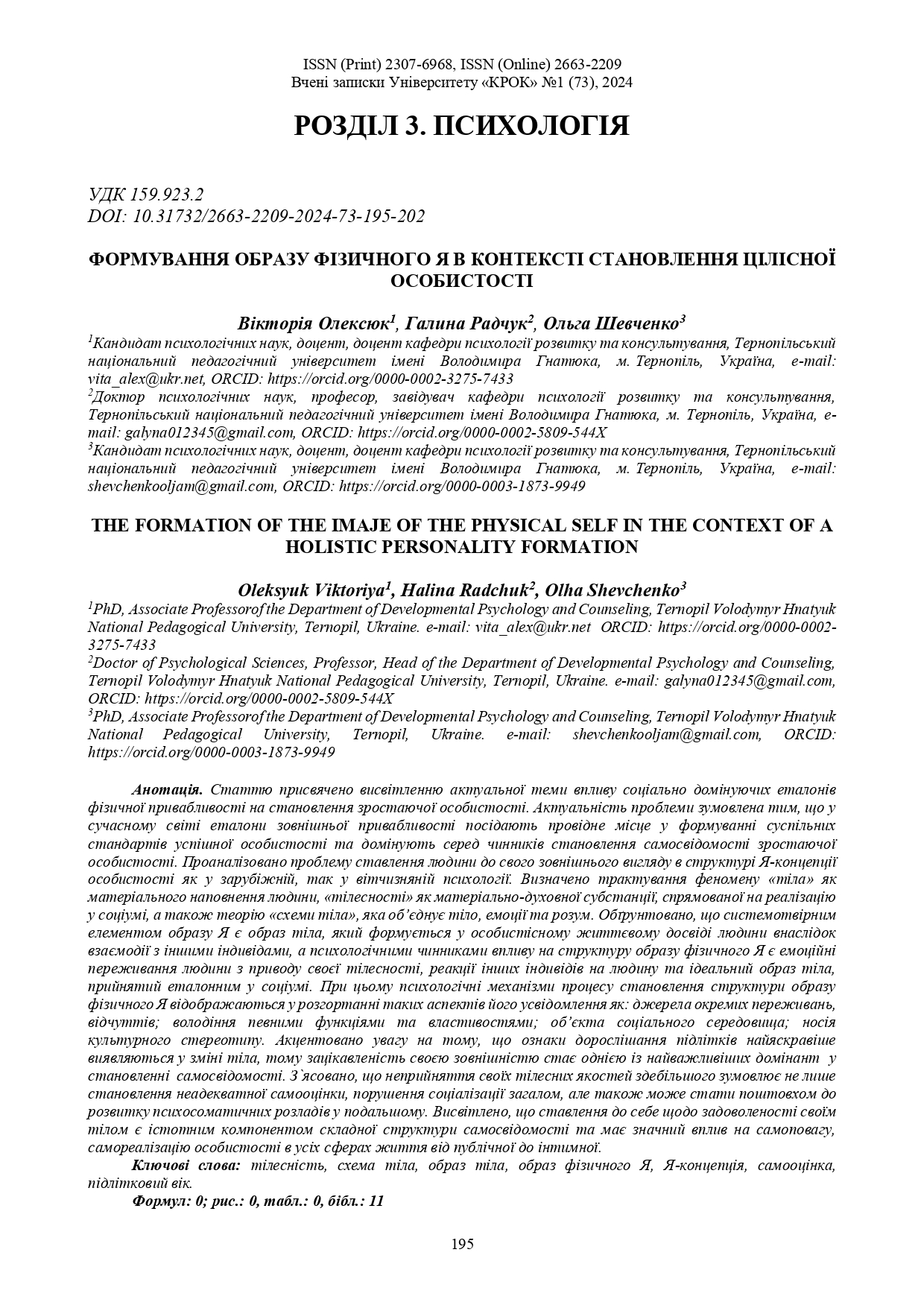TНЕ FORMATION OF THE IMAJE OF THE PHYSICAL SELF IN THE CONTEXT OF A HOLISTIC PERSONALITY FORMATION
DOI:
https://doi.org/10.31732/2663-2209-2024-73-195-202Keywords:
physicality, body schema, body image, image of the physical self, self-concept, self-esteem, adolescenceAbstract
The article is devoted to the coverage of the current issue of the influence of socially dominant standards of physical attractiveness on the formation of a growing person. The relevance of the problem is due to the fact that in the modernworld, the standards of external attractiveness occupy a leading place in the formation of social standards of a successful person and dominate among the factors of formation of the self-awareness of a growing person. The problem of a person’s attitude to his or her appearance in the structure of the self-concept of a personality is analyzed in both foreign and domestic psychology. The interpretation of the phenomenon of «body» as a material filling of a person, «physicality» as a material and spiritual substance aimed at realization in society, as well as the theory of «body schema», which unites body, emotions and mind, is determined. It is substantiated that the backbone element of the self-image is the body image, which is formed in the personal life experience of a person as a result of interaction with other individuals, and the psychological factors influencing the structure of the physical self-image are the emotional experiences of a person about his or her physicality, the reactions of other individuals to a person, and the ideal body image accepted as a reference in society. It is emphasized that the signs of adolescents’ maturation are most clearly manifested in body changes, so interest in their appearance becomes one of the most important dominants in the formation of self-awareness. It is found that the rejection of one’s bodily qualities mostly leads not only to the formation of inadequate self-esteem, disruption of socialization in general, but can also become an impetus for the development of psychosomatic disorders in the future. At the same time, the psychological mechanisms of the process of formation of the physical self image are reflected in the development of the following aspects of its awareness as: a source of individual experiences, feelings; possession of certain functions and properties; an object of the social environment; a carrier of a cultural stereotype. The article highlights that the attitude towards oneself in terms of satisfaction with one’s body is an essential component of the complex structure of self-awareness and has a significant impact on self-esteem, self-realization of the individual in all spheres of life from public to intimate.
Downloads
References
Балахтар, В. В. (2018) Психологія особистості: підручник. Київ: Талком. 384 с.
Колеснікова, Т. В., Сингаївська, І. В. (2020) Психологічні передумови формування іміджу сучасної жінки в соціальних мережах. Держава, регіони, підприємництво: інформаційні, суспільно-правові, соціально-економічні аспекти розвитку: тези доповідей ІІ Міжнародної конференції (Київ, 20 листопада 2020 р.). К. : Університет "КРОК". 44–46.
Максименко, С. Д. (2008) Медична психологія. Вінниця : Нова книга. 704 с.
Моляко, Р. В. (2004) Психокорекційні стратегії деформації Я-образу зовнішності в юнацькому віці. Практична психологія та соціальна робота. № 6. 78–80.
Нечитайло, Т. А. (2010) Генезис образу фізичного Я у підлітковому віці: автореф. дис. на здобуття наук. ступеня канд. психол. наук: спец. 19.00.07 «Педагогічна та вікова психологія». Київ. 20 с.
Сєдих, К. В. & Фільц, О. О. (2017) Основи психотерапії. Київ: Академія. 192 с.
Павлік, Ю. (2013) Тілесність: культурні та соціальні інструменти тіла. Науковий часопис НПУ імені М. П. Драгоманова. Серія 12 «Психологічні науки». 56–41.
Радчук, Г. К. (2014) Аксіопсихологія вищої школи: монографія. Тернопіль: ТНПУ ім. В. Гнатюка. 380 с.
Чабан, О. С. & Хаустова, О. О. (2004) Психосоматичні розлади: нові аспекти розуміння, діагностики та лікування. Нова медицина. № 5. 26–30.
Язвінська, Є. С. (2012) Феномен тілесності: теоретичні і практичні дослідження. Суми: Університетська книга. 302 с.
Horney, K. (1993). The neurotic personality of our time, self-analysis. New York: W.W. Norton Company. 480 p.

Downloads
Published
How to Cite
Issue
Section
License

This work is licensed under a Creative Commons Attribution-NonCommercial 4.0 International License.

